
Wine Culture and Information since 2002 - Volume 22
 Wine Culture and Information since 2002 - Volume 22 |
|
Comparing MarsalaThe most renowned fortified wine of Italy, pride of Sicilian enology, thanks to the many style in which it is being produced, offers interesting opportunities for a comparative tasting |
|
Marsala has always been subject of discussions among wine lovers and tasters, as to create two different and opposed sides of supporters and detractors. Strong of an important past - also marked by a period of decay because of wrong choices which diminished its image and role - Marsala is today proposed to consumers in all of its greatness, showing in glasses its ancient and complex taste. This new life is the result of some responsible and attentive producers who adopted rigorous production techniques, while still keeping its rich tradition and while presenting Marsala back to its ancient splendor. Quality Marsala represents, for the attentive taster, an extraordinary sensorial exercise where the rich aromas and intense flavors of this wine do not leave indifferent. To those who still believe the quality of Marsala is the same of most of the production which was common 20 years ago - when production choices were strongly disputable also because of improbable aromatization - we suggest them to revaluate this wine: we are sure they will not be disappointed. The quality expressed in the last years by the best producers, has definitely left behind those dark times, when Marsala was simply considered a wine suited for cooking. Despite cooking is an art, the connotation and the meaning of this role was certainly not positive or noble. It should however remembered Marsala - the good one - it is still a good companion for cooking and of pastry cooking, capable of giving a refined touch to foods. Moreover, it is obvious to remember using a bad wine in cooking means using a bad ingredient which will certainly not contribute to the final result positively. Marsala is however and above all a great wine to be rediscovered and appreciated, a wine which requires attention and which is capable of giving great emotions. A comparative tasting is therefore a good occasion to rediscover - or to discover for the first time - this magnificent wine, a way to understand the many styles and the role played by the production techniques and grapes in the organoleptic characteristics of this wine.
|
|
The recent history of Marsala began at the end of 1700's when a your English merchant - John Woodhouse - realized its great commercial potentials. This fact represented a fundamental event in the history of Marsala and of its renowned wine, and its development is the result of more than two centuries of intuitions and enological adaptations, a heritage - if we do not consider the period of the 1900's until 1980's - which is still intact in all of its greatness. The richness of Marsala is also expressed in different styles - result of the adoption of many wine making techniques - to which is also added the sweetness factor, that, as a matter of fact, contributes to enrich the number of styles possible. Our comparative tasting will examine three different styles of Marsala, different in the level of sweetness and in the varieties of grapes used. Whoever is interested to know more about the production of Marsala and of its different styles, we suggest reading the article “Marsala” published on the issue 30 of DiWineTaste, May 2005.
The first wine selected for our comparative tasting is Casano's Marsala Superiore Ambra Dolce TerrAntica, produced with Catarratto, Grillo and Grecanico grapes, aged for at least two years in cask. This is the only sweet Marsala of our tasting, whereas the other two are dry. The second wine is Alagna's Marsala Superiore Ambra Secco S.O.M. Baglio Baiata, produced with Grillo, Catarratto and Inzolia grapes - the three typical grapes with which it is historically produced Marsala - aged for at least two years in cask. The third and last wine is Carlo Pellegrino's Marsala Vergine Soleras, produced with the ancient and homonymous method with 100% Grillo grape. Despite the subject is frequently debated, the temperature at which the three wines will be tasted is of 15°C (59°F): this will allow the full development and expression of the complex aromas in the three wines. A lower temperature would not allow the development of aromas, however making wine's acidity more agreeable, whereas higher temperatures would excessively exalt sweetness. The tasting will be done by using three ISO glasses.
|
||||||||
|
The appearance analysis of Marsala, because of the many production techniques, can show a pretty wide range of colors and different transparencies. In fact, according to the production technique and to style, in Marsala is allowed the use of cooked must or mistelle (also called sifone), in order to both increase sweetness as well as to give more structure. The adding of these ingredients will greatly influence color by making it darker. It should be remembered cooked must can be added in the ambra style only. Moreover, aging time and oxidation - two qualities common in every Marsala style - will further influence color by making it darker. In fact, because of the production techniques, it will be impossible to see greenish, straw or golden colors in Marsala: in these wines - even the ones in which it is not used cooked must or mistelle - it will be the amber hue to dominate the scene in the glass. The first wine we will examine is Carlo Pellegrino's Marsala Vergine Soleras. After having poured it in the glass and by tilting it over a white surface, we will notice the color of this wine - which can be observed near the base - will show evident amber yellow hues and the nuances - to the edge of the liquid mass towards the opening of the glass - will show the same color. The second wine we will analyze is Alagna's Marsala Superiore Ambra Secco S.O.M. Baglio Baiata: it will be noticed a deeper color than the previous one, despite it can be however defined as amber. The darker color is caused by the adding of cooked must or mistelle which is allowed in this style. Finally it will be observed the color of Casano's Marsala Superiore Ambra Dolce TerrAntica. In this wine the color will show an even darker hue than the previous ones, characteristic - even in this case - caused by the adding of cooked must or mistelle. Finally, it will be noticed how all the three wines are transparent, noticing the differences according to style.
|
|
The most amazing quality of Marsala is probably represented by its complex, rich and intense aromas. Despite this quality represents an important aspect for every taster, this is probably the characteristic which discourages neophytes. In fact, Marsala cannot be considered an immediate wine, a wine with direct and simple aromas: good Marsala requires a good deal of attention and curiosity. Worth companion of countless enogastronomical matchings, Marsala is also a good wine to be sipped in meditation while contemplating its rich aromas. Moreover, a good Marsala Vergine - possibly aged for some tens of years - can be excellently served in place of a distillate. The first wine of which we will examine aromas if Casano's Marsala Superiore Ambra Dolce TerrAntica. By holding the glass in vertical position and without swirling, it will be done the first smell in order to perceive opening aromas. This initial evaluation will develop aromas of fig jam and almond, as well as a complex and vaguely pungent aroma hardly associable by analogy. It is a particular aroma typical in many fortified wines, which develops as a consequence of a prolonged and strong oxidation, usually defined with the Spanish term rancio, as it is a typical aroma in Jerez (Sherry). Rancio - frequently defined as maderized - is an aroma which can apparently be considered as a fault, however it is a peculiar and typical quality in this style of wines, an aroma making even more complex the bouquet of the wine. After having swirled the glass, a second smell will allow the perception of apricot jam, citrus fruit peel, date and caramel aromas. The second wine we will examine is Alagna's Marsala Superiore Ambra Secco S.O.M. (Superior Old Marsala) Baglio Baiata. Firstly, we will evaluate opening aromas by holding the glass in vertical position and without swirling. It will be perceived aromas of dried fig, almond and the typical hints of rancio, in this wine more intense and evident than the previous one. After having swirled the glass, it will be possible to perceive aromas of honey, caramel, leather, toasted and citrus fruit peel. The last wine of which we will examine aromas is Carlo Pellegrino's Marsala Vergine Soleras. The first smell, by holding the glass still, will allow the perception of rancio, dried fig and almond aromas. It will be noticed how the aroma of rancio is in this wine more intense than the previous ones, result of a longer aging and oxidation. After having swirled the glass, a second smell will allow the perception of date, dried apricot, licorice, walnut, orange marmalade, enamel and leather. It will be noticed how in all the three wines can be perceived the ethereal aroma of alcohol - a normal quality in fortified wines - whose presence also favors the perception of all the other aromas. The aromatic qualities of Marsala, besides the typical oxidized hint of rancio, is characterized by aromas of dried fruit and jams to which are also added spice and ethereal aromas of alcohol and enamel.
|
||||
|
Marsala is a fortified wine, therefore one of its main gustatory qualities is represented by the burning tactile sensation caused by alcohol. The high quantity of alcohol found in Marsala requires organoleptic quality in order to balance this primary factor, in particular a good acidity, astringency and sweetness. The gustatory analysis of Marsala must then go beyond the simple evaluation of the initial impact caused by alcohol that, because of its high quantity, could distract the taster from the analysis of the other organoleptic characteristics. The first wine of which we will examine the taste is the driest of the three: Carlo Pellegrino's Marsala Vergine Soleras. The first sip will immediately denote the high quantity of alcohol present in the wine, however concentrate your attention on acidity, which is well evident and which balances the strong alcohol volume. Moreover, evaluate the very dry taste and the appreciable astringency caused by the long period of aging in cask. Even the structure will be pretty high. The second wine we will examine is Alagna's Marsala Superiore Ambra Secco S.O.M. Baglio Baiata. Even in this case the attack in the mouth will be alcoholic, however - after this initial impact - it will be possible to perceive the acidity of the wine and, as opposed to the previous wine, a slight sweet taste and a higher roundness. It should be remembered this is a Marsala ambra, therefore the adding of cooked must or mistelle is responsible for the presence of these two organoleptic qualities. Just like the previous wine, even the structure in this Marsala is pretty high. The last wine we will examine is Casano's Marsala Superiore Ambra Dolce TerrAntica. Even in this case the attack in the mouth will be characterized by a strong alcoholicity, sensation which will soon leave the scene to the evident sweetness of wine. Acidity, despite it is appreciable, seems to be less evident because of the presence of residual sugar, a characteristic which also contributes to increase roundness of this wine as opposed to the previous ones.
|
|
Besides the interesting aromas, one of the good qualities of Marsala - and of fortified wines in general - is the pretty long taste-olfactory persistence, sometimes very persistent. All the three wines are characterized by a good taste-olfactory correspondence, where dried fig, date and caramel are perceivable both in the nose and in the mouth. The finish of Casano's Marsala Superiore Ambra Dolce TerrAntica will be characterized by flavors of dried fig and caramel, whereas to the finish of Alagna's Marsala Superiore Ambra Secco S.O.M. Baglio Baiata will be added a flavor of almond. The finish of Carlo Pellegrino's Marsala Vergine Soleras is persistent with flavors of dried fig, almond and date. Quality Marsala is a wine which expresses in the glass an extraordinary complexity and a charm recalling to mind the memory of aromas and flavors of past times, a wine which can be well matched to cheese, desserts and robust foods, as well as tasted alone - away from the frenzy of modern times - in absolute meditation.
|
Wines of the Month |
|
|
|
Score legend Prices are to be considered as indicative. Prices may vary according to the country or the shop where wines are bought |
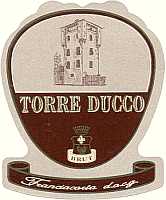
|
|
Franciacorta Brut Torre Ducco |
|
| Catturich Ducco (Lombardy, Italy) | |
| Grapes: Chardonnay (90%), Pinot Blanc (10%) | |
| Price: € 13.00 | Score: |
| This Franciacorta shows an intense golden yellow color and nuances of golden yellow, very transparent, good effervescence, fine and persistent perlage. The nose reveals intense, clean, pleasing and refined aromas which start with hints of bread crust and yeast followed by aromas of banana, hawthorn, apple, pear, plum, grapefruit, hazelnut, honey and praline. The mouth has good correspondence to the nose, an effervescent and crisp attack, however balanced by alcohol, good body, intense flavors, pleasing roundness. The finish is persistent with flavors of hazelnut, banana and plum. Part of the Chardonnay used for this wine ages in barrique. This Franciacorta ages in bottle on its lees for at least 36 months. | |
| Food Match: Pasta with legumes, Roasted fish, Roasted white meat, Stewed fish | |
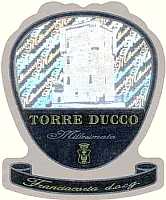
|
|
Franciacorta Pas Dosè Millesimato Torre Ducco 1997 |
|
| Catturich Ducco (Lombardy, Italy) | |
| Grapes: Chardonnay (70%), Pinot Noir (30%) | |
| Price: € 18.00 | Score: |
| This Franciacorta shows a brilliant golden yellow color and nuances of golden yellow, very transparent, good effervescence, fine and persistent perlage. The nose reveals intense, clean, pleasing, refined and elegant aromas that start with hints of yeast, bread crust and hazelnut followed by aromas of banana, acacia, butter, grapefruit, praline, plum, apple and vanilla. The mouth has good correspondence to the nose, a crisp and effervescent attack, however balanced by alcohol, good body, intense flavors, agreeable. The finish is persistent with flavors of grapefruit, apple and hazelnut. Part of the Chardonnay used for this wine ages in barrique. This Franciacorta ages in bottle on its lees for at least 84 months. | |
| Food Match: Roasted fish, Roasted white meat, Stewed meat | |
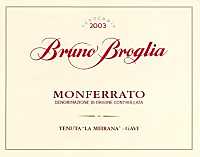
|
|
Monferrato Rosso Bruno Broglia 2003 |
|
| Broglia (Piedmont, Italy) | |
| Grapes: Barbera, Cabernet Sauvignon, Merlot | |
| Price: € 19.00 | Score: |
| This wine shows a brilliant ruby red color and nuances of ruby red, moderate transparency. The nose denotes intense, clean and pleasing aromas which start with hints of black cherry, plum and violet followed by aromas of blueberry, blackberry, black currant and vanilla. The mouth has good correspondence to the nose, a slightly tannic attack and however balanced by alcohol, good body, intense flavors. The finish is persistent with flavors of black cherry and plum. This Monferrato Rosso ages for 18 months in barrique. | |
| Food Match: Roasted meat, Broiled meat and barbecue, Braised and stewed meat | |
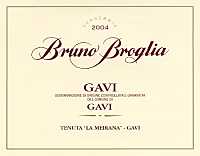
|
|
Gavi di Gavi Bruno Broglia 2004 |
|
| Broglia (Piedmont, Italy) | |
| Grapes: Cortese | |
| Price: € 19.00 | Score: |
| The wine shows an intense greenish yellow color and nuances of greenish yellow, very transparent. The nose denotes intense, clean, pleasing and refined aromas that start with hints of pear, apple and peach followed by aromas of pineapple, hawthorn, litchi, medlar and broom. The mouth has good correspondence to the nose, a crisp attack and however balanced by alcohol, good body, intense flavors, agreeable. The finish is persistent with flavors of pear, pineapple and peach. This Gavi ages in steel tanks. | |
| Food Match: Roasted fish, Stewed fish, Broiled crustaceans | |
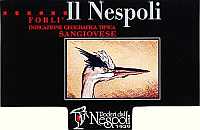
|
|
Il Nespoli 2003 |
|
| Podere dal Nespoli (Emilia Romagna, Italy) | |
| Grapes: Sangiovese | |
| Price: € 13.40 | Score: |
| The wine shows a brilliant ruby red color and nuances of garnet red, moderate transparency. The nose reveals intense, clean and pleasing aromas which start with hints of cherry, raspberry and plum followed by aromas of cyclamen, vanilla, licorice and menthol. The mouth has good correspondence to the nose, a slightly tannic attack and however balanced by alcohol, good body, intense flavors. The finish is persistent with flavors of cherry, plum and raspberry. Il Nespoli ages for 12 months in barrique. | |
| Food Match: Stewed meat with mushrooms, Roasted meat, Hard cheese | |
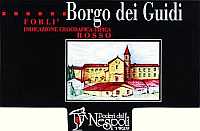
|
|
Borgo dei Guidi 2001 |
|
| Podere dal Nespoli (Emilia Romagna, Italy) | |
| Grapes: Sangiovese (70%), Cabernet Sauvignon (25%), Raboso del Piave (5%) | |
| Price: € 21.00 | Score: |
| This wine shows an intense ruby red color and nuances of ruby red, little transparency. The nose denotes intense, clean, pleasing and refined aromas which start with hints of plum and blueberry followed by aromas of black cherry, black currant, vanilla, licorice, tobacco, menthol, cinnamon and hints of bell pepper. The mouth has good correspondence to the nose, a tannic attack and however balanced by alcohol, good body, intense flavors. The finish is persistent with flavors of black currant, plum and black cherry. A well made wine. Borgo dei Guidi ages for 12 months in barrique followed by 12 months of aging in bottle. | |
| Food Match: Roasted meat, Stewed and braised meat with mushrooms, Hard cheese | |
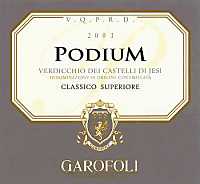
|
|
Verdicchio dei Castelli di Jesi Classico Superiore Podium 2003 |
|
| Garofoli (Marches, Italy) | |
| Grapes: Verdicchio | |
| Price: € 11.00 | Score: |
| The wine shows a brilliant straw yellow color and nuances of greenish yellow, very transparent. The nose denotes intense, clean, pleasing and refined aromas which start with hints of jasmine, apple and pear followed by aromas of pineapple, hawthorn, broom, honey, citrus fruits, almond and plum. The mouth has good correspondence to the nose, a crisp attack and however balanced by alcohol, good body, intense flavors, agreeable. The finish is persistent with flavors of plum, apple and pear. A well made wine. Verdicchio Podium ages for 15 months in steel tanks followed by 4 months of aging in bottle. | |
| Food Match: Roasted fish, Stuffed pasta, Stewed fish, Roasted white meat | |
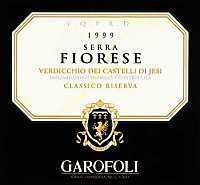
|
|
Verdicchio dei Castelli di Jesi Classico Superiore Riserva Serra Fiorese 2002 |
|
| Garofoli (Marches, Italy) | |
| Grapes: Verdicchio | |
| Price: € 12.50 | Score: |
| This Verdicchio shows a brilliant golden yellow color and nuances of straw yellow, very transparent. The nose reveals intense, clean, pleasing, refined and elegant aromas which start with hints of quince, plum and apricot followed by aromas of hawthorn, broom, pineapple, pear, peach, vanilla, litchi and almond. The mouth has very good correspondence to the nose, a crisp attack and pleasing smoothness, however well balanced by alcohol, good body, intense flavors, agreeable. The finish is persistent with flavors of plum, apricot and quince. A well made wine. Verdicchio Serra Fiorese ages for 11 months in barrique followed by at least 12 months of aging in bottle. | |
| Food Match: Roasted fish, Roasted white meat, Stewed fish, Stuffed pasta with mushrooms | |
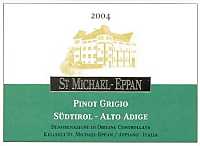
|
|
Alto Adige Pinot Grigio 2004 |
|
| San Michele Appiano (Alto Adige, Italy) | |
| Grapes: Pinot Gris | |
| Price: € 6.00 | Score: |
| This wine shows a brilliant greenish yellow color and nuances of greenish yellow, very transparent. The nose denotes intense, clean and pleasing aromas which start with hints of pear and pineapple followed by aromas of lemon, apple, hawthorn and broom. The mouth has good correspondence to the nose, a crisp attack and however balanced by alcohol, good body, intense flavors. The finish is persistent with flavors of pear and pineapple. This Pinot Gris ages in steel tanks. | |
| Food Match: Fish appetizers, Pasta and risotto with crustaceans, Eggs | |
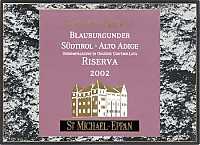
|
|
Alto Adige Pinot Nero Riserva 2002 |
|
| San Michele Appiano (Alto Adige, Italy) | |
| Grapes: Pinot Noir | |
| Price: € 10.70 | Score: |
| This Pinot Noir shows a pale ruby red color and nuances of brick red, moderate transparency. The nose reveals intense, clean, pleasing and refined aromas which start with hints of cherry and raspberry followed by aromas of strawberry, cyclamen, rose, plum, licorice and vanilla. The mouth has good correspondence to the nose, a slightly tannic attack and pleasing crispness, however balanced by alcohol, good body, intense flavors, agreeable. The finish is persistent with flavors of cherry, raspberry and strawberry. This wine ages for 12 months in cask. | |
| Food Match: Roasted meat, Stewed meat with mushrooms | |
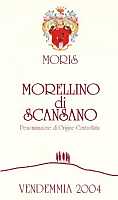
|
|
Morellino di Scansano 2004 |
|
| Moris Farms (Tuscany, Italy) | |
| Grapes: Sangiovese (90%), Cabernet Sauvignon, Syrah (10%) | |
| Price: € 8.00 | Score: |
| This wine shows a brilliant ruby red color and nuances of ruby red, moderate transparency. The nose denotes intense, clean and pleasing aromas which start with hints of raspberry and plum followed by aromas of cherry, strawberry, blueberry, cyclamen and violet. The mouth has good correspondence to the nose, a slightly tannic attack and however balanced by alcohol, good body, intense flavors. The finish is persistent with flavors of cherry, raspberry and blueberry. This Morellino di Scansano ages for 4 months in steel tanks followed by at least 2 months of aging in bottle. | |
| Food Match: Sauteed meat with mushrooms, Stuffed pasta, Broiled meat and barbecue | |
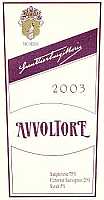
|
|
Avvoltore 2003 |
|
| Moris Farms (Tuscany, Italy) | |
| Grapes: Sangiovese (75%), Cabernet Sauvignon (20%), Syrah (5%) | |
| Price: € 26.00 | Score: |
| The wine shows an intense ruby red color and nuances of ruby red, little transparency. The nose reveals intense, clean, pleasing, refined and elegant aromas which start with hints of black currant, black cherry and plum followed by aromas of blueberry, blackberry, violet, vanilla, cocoa, eucalyptus, licorice and tobacco. The mouth has good correspondence to the nose, a tannic attack and however balanced by alcohol, full body, intense flavors. The finish is persistent with flavors of black currant, plum and black cherry. A well made wine. Avvoltore ages for about 12 months in barrique followed by 6 months of aging in bottle. | |
| Food Match: Game, Roasted meat, Braised and stewed meat, Hard cheese | |
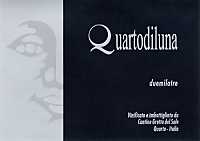
|
|
Quartodiluna 2003 |
|
| Cantine Grotta del Sole (Campania, Italy) | |
| Grapes: Falanghina, Coda di Volpe | |
| Price: € 13.60 | Score: |
| This wine shows a brilliant straw yellow color and nuances of straw yellow, very transparent. The nose reveals intense, clean, pleasing and refined aromas which start with hints of hazelnut and apple followed by aromas of hawthorn, plum, pineapple, vanilla, toasted, broom and almond. The mouth has good correspondence to the nose, a crisp attack and pleasing roundness, however balanced by alcohol, good body, intense flavors, agreeable. The finish is persistent with flavors of apple, plum and pineapple. Quartodiluna ages for 6 months in barrique followed by 4 months of aging in bottle. | |
| Food Match: Stuffed pasta, Roasted white meat, Roasted fish, Fish and mushrooms soups | |
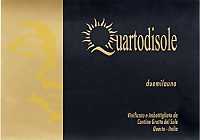
|
|
Quartodisole 2003 |
|
| Cantine Grotta del Sole (Campania, Italy) | |
| Grapes: Piedirosso, Aglianico | |
| Price: € 17.00 | Score: |
| The wine shows an intense ruby red color and nuances of ruby red, little transparency. The nose reveals intense, clean, pleasing and refined aromas which start with hints of black cherry, blueberry and plum followed by aromas of carob, blackberry, vanilla, tobacco, licorice and menthol. The mouth has good correspondence to the nose, a tannic attack and however balanced by alcohol, full body, intense flavors. The finish is persistent with flavors of black cherry, plum and blueberry. A well made wine. Quartodisole ages for 12 months in barrique followed by 4 months of aging in bottle. | |
| Food Match: Game, Roasted meat, Stewed and braised meat | |
|
||||||||
|
DiWineTaste Polls
|
| |||||||
Privacy Policy | |||||||


| Copyright © 2002-2024 Antonello Biancalana, DiWineTaste - All rights reserved |
| All rights reserved under international copyright conventions. No part of this publication and of this WEB site may be
reproduced or utilized in any form or by any means, electronic or mechanical, without permission in writing from DiWineTaste. |